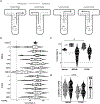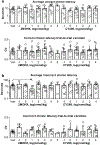Characterization of behavioral changes in T-maze alternation from dopamine D1 agonists with different receptor coupling mechanisms
- PMID: 37578525
- PMCID: PMC10693963
- DOI: 10.1007/s00213-023-06440-5
Characterization of behavioral changes in T-maze alternation from dopamine D1 agonists with different receptor coupling mechanisms
Abstract
Rationale: Dopamine D1 receptor agonists have been shown to improve working memory, but often have a non-monotonic (inverted-U) dose-response curve. One hypothesis is that this may reflect dose-dependent differential engagement of D1 signaling pathways, a mechanism termed functional selectivity or signaling bias.
Objectives and methods: To test this hypothesis, we compared two D1 ligands with different signaling biases in a rodent T-maze alternation task. Both tested ligands (2-methyldihydrexidine and CY208243) have high intrinsic activity at cAMP signaling, but the former also has markedly higher intrinsic activity at D1-mediated recruitment of β-arrestin. The spatial working memory was assessed via the alternation behavior in the T-maze where the alternate choice rate quantified the quality of the memory and the duration prior to making a choice represented the decision latency.
Results: Both D1 drugs changed the alternate rate and the choice latency in a dose-dependent manner, albeit with important differences. 2-Methyldihydrexidine was somewhat less potent but caused a more homogeneous improvement than CY208243 in spatial working memory. The maximum changes in the alternate rate and the choice latency tended to occur at different doses for both drugs.
Conclusions: These data suggest that D1 signaling bias in these two pathways (cAMP vs β-arrestin) has complex effects on cognitive processes as assessed by T-maze alternation. Understanding these mechanisms should allow the identification or discovery of D1 agonists that can provide superior cognitive enhancement.
Keywords: Dopamine D1 agonist; Functional selectivity/signaling bias; Rodent T-maze alternation; Spatial working memory.
© 2023. The Author(s), under exclusive licence to Springer-Verlag GmbH Germany, part of Springer Nature.
Conflict of interest statement
Figures





Similar articles
-
Dose-Dependent Regulation on Prefrontal Neuronal Working Memory by Dopamine D1 Agonists: Evidence of Receptor Functional Selectivity-Related Mechanisms.Front Neurosci. 2022 Jun 16;16:898051. doi: 10.3389/fnins.2022.898051. eCollection 2022. Front Neurosci. 2022. PMID: 35784852 Free PMC article.
-
D1 dopamine receptors intrinsic activity and functional selectivity affect working memory in prefrontal cortex.Mol Psychiatry. 2021 Feb;26(2):645-655. doi: 10.1038/s41380-018-0312-1. Epub 2018 Dec 7. Mol Psychiatry. 2021. PMID: 30532019 Free PMC article.
-
Identification of G protein-biased agonists that fail to recruit β-arrestin or promote internalization of the D1 dopamine receptor.ACS Chem Neurosci. 2015 Apr 15;6(4):681-92. doi: 10.1021/acschemneuro.5b00020. Epub 2015 Feb 20. ACS Chem Neurosci. 2015. PMID: 25660762 Free PMC article.
-
Under the curve: critical issues for elucidating D1 receptor function in working memory.Neuroscience. 2006 Apr 28;139(1):263-76. doi: 10.1016/j.neuroscience.2005.09.028. Epub 2005 Nov 28. Neuroscience. 2006. PMID: 16310964 Review.
-
Functional Selectivity of Dopamine D1 Receptor Signaling: Retrospect and Prospect.Int J Mol Sci. 2021 Nov 3;22(21):11914. doi: 10.3390/ijms222111914. Int J Mol Sci. 2021. PMID: 34769344 Free PMC article. Review.
Cited by
-
Cortico-striatal circuit mechanisms drive the effects of D1 dopamine agonists on memory capacity in mice through cAMP/PKA signalling.Nat Commun. 2025 Mar 17;16(1):2615. doi: 10.1038/s41467-025-57788-5. Nat Commun. 2025. PMID: 40097401 Free PMC article.
-
Dopamine D1 Receptor Agonists Rescue Age-related Decline in Temporal Order Memory.Neuroscience. 2024 Jul 23;551:177-184. doi: 10.1016/j.neuroscience.2024.05.033. Epub 2024 May 31. Neuroscience. 2024. PMID: 38823551 Free PMC article.
-
Levo-Stepholidine as a Potential Cognitive Enhancer: Insights into Executive Function and Memory Improvements.Biomedicines. 2024 Nov 25;12(12):2680. doi: 10.3390/biomedicines12122680. Biomedicines. 2024. PMID: 39767588 Free PMC article.
References
-
- Abbott B, Starr BS, Starr MS (1991) CY 208–243 behaves as a typical D-1 agonist in the reserpine-treated mouse. Pharmacol Biochem Behav 38:259–263 - PubMed
-
- Andersen PH, Jansen JA (1990) Dopamine receptor agonists: selectivity and dopamine D1 receptor efficacy. Eur J Pharmacol 188:335–347 - PubMed
-
- Arnsten AF, Cai JX, Murphy BL, Goldman-Rakic PS (1994) Dopamine D1 receptor mechanisms in the cognitive performance of young adult and aged monkeys. Psychopharmacology 116:143–151 - PubMed
-
- Atkinson RC, Shiffrin RM (1971) The control of short-term memory. Sci Am 225:82–90 - PubMed
MeSH terms
Substances
Grants and funding
LinkOut - more resources
Full Text Sources

